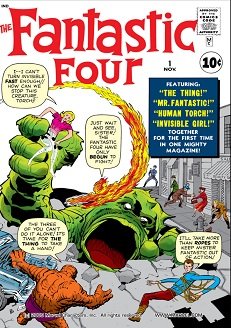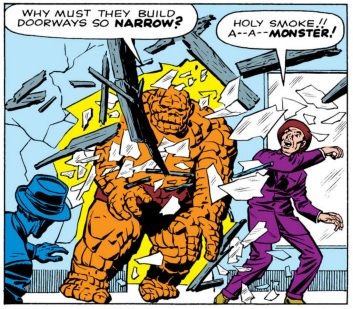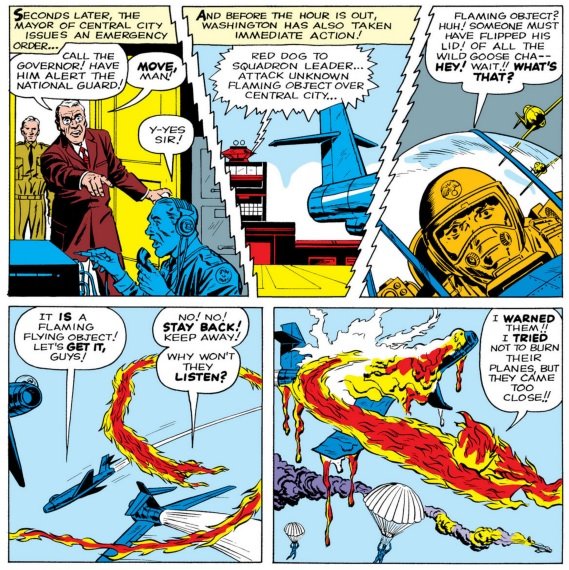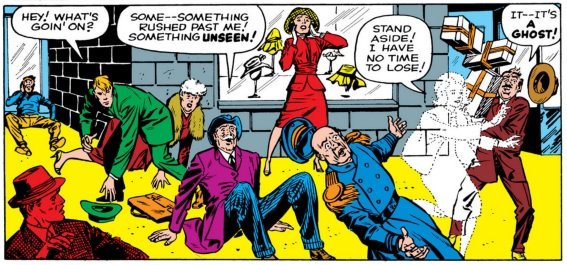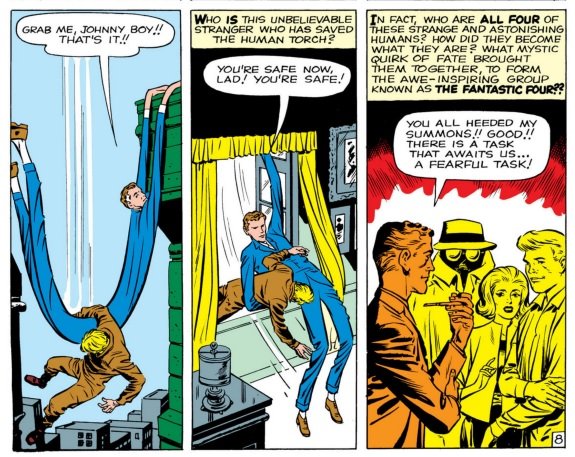14 Monster Families from The Munsters, Charmed, Hotel Transylvania, and more
Even monsters need family support!
A look at monster family creations including those from Bewitched, Addams Family, Fantastic Four, Ray Bradbury, Dan Brereton, and more!
Monsters and other figures of the magical, the mystical, or the cryptozoological are people, too. (Well, kinda.) The folks we meet from The Munsters—or other families on this list—include family members just trying to make it. If we look back over the history of these kinds of stories, we see that even the Universal Monsters were sometimes victims who deserved a break. Family is important because they can offer support and unconditional love—even when the world is against us.
The list below shows examples of families that deal with their members being, well, different. The list include the Addams Family, Samantha’s family from Bewitched, the sisters on Charmed, the family from Dark Shadows, the monster family The Elliots created by Ray Bradbury, The Gruesomes and The Frankenstones (both from The Flintstones), Dracula’s extended family from Hotel Transylvania, The Wishbones from Monster Family, The Munsters, the Nocturnals, Sabrina the Teenage Witch and her aunts, Witch Lezah and Gossamer from The Looney Tunes Show, and even the Fantastic Four.
Which of these are your favorites? Who would YOU add to the list? Let us know in the comments below!
If below you meet some families for the first time, feel free to check them out. Remember to tell them that Monster Complex says hello!
Related articles on Monster Complex
Episode: THE MUNSTERS and FANTASTIC FOUR have SO MUCH in common
Were THE MUNSTERS inspired by Marvel Comics? 13 surprising similarities
Monster Complex™ uses Amazon affiliate links. As an Amazon associate I earn from qualifying purchases. (At no additional charge to you.)
This article was posted November 2022. We revised the article a few times since then—including May 2024.
14 Monster Families
Addams Family
The Addams Family is an unconventional household that is fond of the morbid and grotesque, but don’t realize that people find them scary. Created by cartoonist Charles Addams in 1938, they started out as a series of one-panel cartoons, published in The New Yorker over a 50-year period. They have since been adapted to other media, including more than one television series, numerous films, video games, a stage musical, and more.
The History of the Addams Family
More Addams Family on Monster Complex:
Samantha Stephens’ family (Bewitched)
TV series Bewitched (1964-1972), ranked by TV Guide as one of the “50 Greatest TV Shows of All Time,” is a fantasy sitcom about a witch—in this scenario, witches and warlocks are nonhuman beings from another dimension—who marries a “mortal” and plans to lead the life of a normal family. However, members of her magical family keep showing up, making “normal” a hard thing to achieve.
Created by Sol Saks, Bewitched revolved around Samantha and Darrin Stephens. Samantha, a witch, was played by Elizabeth Montgomery. Darrin, a mortal, was played first by Dick York, and then by Dick Sargent. Over the course of the series the couple had two children.
Other members of Samantha’s family who would come to visit included Samantha’s mother, Endora (played by Agnes Moorehead); Samantha’s father, Maurice (played by Maurice Evans); Samantha’s Aunt Clara (played by Marion Lorne); Samantha’s Uncle Arthur (played by Paul Lynde); and Samantha’s cousin Serena (also played by Elizabeth Montgomery).
The show was revisited by a spinoff sitcom revolving around Darrin’s and Samantha’s daughter, Tabitha. There was also a film adaptation that got a mixed reaction (to be honest, I liked it) that treated the original series as a well, a television show—which had its own magical powers.
Bewitched: History of the Show
More related articles on Monster Complex
11 Sci-Fi Versions of ‘A Christmas Carol’ (including that time on BEWITCHED)
D.M. Guay: Horror Author Q&A—“My goal is to hope like hell it will make readers laugh.”
Charlaine Harris Q&A: Gunnie Rose series continues with ‘All the Dead Shall Weep’
Deborah Wilde on ‘Big Demon Energy’—An Enemies-to-Lovers Urban Fantasy
The sisters on Charmed
Charmed is a fantasy drama television series that follows a trio of sisters—The Charmed Ones—who are the most powerful good witches of all time. They use their combined “Power of Three” to protect innocent lives from evil.
The original series revolved around the three Halliwell sisters, Prue (Shannen Doherty), Piper (Holly Marie Combs), and Phoebe (Alyssa Milano). Following Prue’s death in the third-season finale, their long-lost half sister Paige Matthews (Rose McGowan) assumes her place within the “Power of Three” from season four on. The show was originally created by Constance M. Burge and produced by Aaron Spelling and his production company Spelling Television. The original series was broadcast by The WB 1998-2006.
The reboot of Charmed aired 2018-2022. That was developed by Jennie Snyder Urman, Jessica O’Toole, and Amy Rardin. The new version of the show focused on being more diverse by casting three women of color in the lead roles, and for its LGBT representation by making one of the sisters a lesbian.
Find Charmed (first version) at Amazon
Find Charmed (second version) at Amazon
Charmed: New Showrunners Talk About Season 4
The Collins Family (Dark Shadows)
Dark Shadows (1966-1971), a weekday gothic soap opera, featured the life and difficulties of a family in a town dealing with a number of supernatural occurrences. The series started small, but the audience exploded with the addition of vampire Barnabas Collins (Jonathan Frid). The show also featured an assortment of monsters and evildoers.
The original show lasted nearly five years (1,225 episodes). The show spawned feature films, TV remakes, a series of novels, plus a series of audiodramas. TV Guide’s list of Top Cult Shows ranked Dark Shadows #19 in 2004 and #23 in 2007.
Casting Shadows: 1987 Dark Shadows documentary
More vampires on Monster Complex:
The Elliots (From the Dust Returned by Ray Bradbury)
Storyteller Ray Bradbury (1920-2012) was a popular author in a variety of genres, including science fiction, horror, fantasy, mystery, and realistic fiction. His books include such titles as Fahrenheit 451 (1953), The Martian Chronicles (1950), and Something Wicked This Way Comes (1962).
His fantasy book From the Dust Returned featured stories about the Elliotts, a family of Illinois-based ghosts and monsters. The first edition of From the Dust Returned featured a cover illustration by Addams Family creator Charles Addams, originally made to accompany the 1946 publication of the first Elliott story, “Homecoming,” in Mademoiselle.
The Elliotts bear a strong resemblance to Addams’ own characters. Bradbury and Addams discussed developing a history of the Elliotts, but that project never happened.
Related links on Monster Complex:
The Gruesomes and The Frankenstones (The Flintstones)
Over the years, The Flintstones actually met two different monster families. The first one, The Gruesomes, moved in next door to the Flintstones during the fifth season of the original 1960-1966 series. The second family, the Frankenstones, appeared on The Flintstones spin-offs and television specials through the early 1980s.
You’d think it would be tough to tell the difference between two monster families on the same show—but the Gruesomes were Stone aged versions of the Addams Family, and The Frankenstones were Stone aged versions of the Universal Monsters (which made them kind of like The Munsters). You can watch samples of both families below.
Find Flintstones Season 5 or episodes at Amazon
Find Flintstones Meet Rockula & Frankenstone at Amazon (1979)
Meet the Gruesomes
Meet the Frankenstones
Bonus: That time Bewitched was on The Flintstones
Bewitched stars Elizabeth Montgomery and Dick York showed up on The Flintstones as cave people versions of their characters from Bewitched. (They appeared in episode 6.6 of the cartoon series.)
Related links on Monster Complex:
Military Monsters ‘Creature Commandos’ returning in new TV show, new comic book
25 Iconic Robot TV Shows—including cartoons, MST3K, Star Trek, Westworld, and more
Moon Girl and Devil Dinosaur: 13 Facts Behind the Disney+ Series
The GODZILLA Issue: Godzilla, Kong, and Gamera Movies, Games, Cartoons, More
Dracula’s family (Hotel Transylvania)
The start of a film series and spin-off TV show, Hotel Transylvania was a charming re-imagining of the Universal Monsters that showed Count Dracula as the owner of a monster’s-only hotel. The series starts with Dracula and his daughter, Mavis, and over time the family grows to include Mavis’ husband, Johnny, and their son, Dennis. Also part of the family is Lydia Dracula, who is Dracula’s sister and Mavis’ aunt. She’s a regular part of Hotel Transylvania: The Series.
Throughout the series we also spend time with Dracula’s close-knit group of friends, which includes Frankenstein’s monster, a werewolf, a mummy, and an invisible man, among others. Their children are part of Hotel Transylvania: The Series.
Over the films and TV series the voice cast has included Adam Sandler, Andy Samberg, Selena Gomez, Kevin James, Steve Buscemi, David Spade, CeeLo Green, Fran Drescher, Molly Shannon, Jon Lovitz, Chris Parnell, Kathryn Hahn, Jim Gaffigan, Keegan-Michael Key, Brian Hull, Brad Abrell, Asher Blinkoff, Tyler “Ninja” Blevins, and Zoe Berria, Bryn McAuley, Evany Rosen, Gage Munroe, Joseph Motiki, and Dan Chameroy, among others.
Fantastic Four
When someone today looks at the members of the FF for the first time, the first reaction is to think, “Oh, look, one of them is a monster.” But I’ve recently discovered that they are all monsters. And how in many ways, the Fantastic Four led the way for so much of what we now appreciate about the Marvel Comics Universe…
In recent months I’ve started reading classic comic books, including the Fantastic Four comic book series starting with issue #1 and reading the whole series consecutively. At the same time, I’ve been reading books that explore the bigger picture—books like All of the Marvels: A Journey to the Ends of the Biggest Story Ever Told by Douglas Wolk, Slugfest: Inside the Epic, 50-year Battle between Marvel and DC by Reed Tucker, and Marvel Comics: The Untold Story by Sean Howe.
One of the surprising things I discovered about the history of Marvel Comics is how much the original creators—notably, Stan Lee, Jack Kirby and Steve Ditko—had spent the previous years working on comic book genres other than “super heroes.” So, when Lee and Kirby launched Fantastic Four (and Lee and Ditko soon launched Amazing Spider-Man), they actually mixed together several genres. Compared to costumed vigilantes at other comic book publishers, where you find examples that are more flat and interchangeable, the Marvel Comics results were striking and fresh.
The 1961 debut of Fantastic Four was a character-driven drama that featured a bickering family of monsters who reluctantly became heroes. And not just a “team” like Avengers or X-Men, but an extended family that included a couple (who eventually become married), a brother and a college friend. And if you read those early issues in context, you can really see how they broke ground.
Struck by cosmic rays during a brief space flight, all four of them were transformed. One of them became a lumbering orange beast; one became a flaming man; one became an invisible woman (which is, literally, the title of a Universal Monsters movie); and the mad scientist among them became a freak that could stretch his body in all directions.
Early appearances showed how members of the general public would go crazy when they ran into them. (One scene found members of the public arguing over whether the FF members were simply urban legends.)
Over the years, the Fantastic Four have appeared in TV cartoons and big screen movies. The films include the 1994 Roger Corman-produced film that was never actually released—and has only been seen as a bootleg (it’s really weird); the 2005 film Fantastic Four and its 2007 sequel Fantastic Four: Rise of the Silver Surfer; and Fantastic Four (2015). For years, the film rights were held by Fox studios, dating back to Marvel Comics’ financial woes in the 1990s. When Disney studios bought Marvel, and later bought Fox, the film rights returned to Marvel—so it’s only a matter of time before the FF joins the MCU.
Related articles on Monster Complex:
The Wishbones (Monster Family)
Based on the German language children’s book Happy Family by David Safier, the animated film Monster Family introduces the family The Wishbones and they are not happy. With a struggling bookshop, an overworked husband, and two misunderstood teenagers, Emma is at her wit’s end trying to be the perfect mom.
Dragging her family to a costume party Halloween night, they’re cursed by an evil witch and transformed into a vampire, a mummy, a werewolf, and Frankenstein’s monster. Now Emma will fight to keep her Monster Family together and uncover the secret of their curse—eventually leading them to the Prince of Darkness himself…Dracula!
By the end, the family’s experiences as “monsters” improves their standing in life. The film was also followed with a sequel.
Find Monster Family and Monster Family 2 at Amazon
MONSTER FAMILY Official Trailer
The Munsters
The 1960s classic sitcom The Munsters introduced viewers to a family of monsters. This included a dad who was a version of Frankenstein’s Monster, a grandpa who was the retired Count Dracula, a mom who was the daughter of Dracula, a son who was a werewolf, and a niece that was normal. (Granted, the family thought she was the weird one.)
When the creators originally pitched the series, they had something in mind much closer to the Addams Family comics in the New Yorker. Universal liked their idea, but had something different in mind. (More details about this process here.)
With 70 episodes, the original sitcom The Munsters aired on the CBS network 1964-1966. Despite airing only two seasons, the show has continued to delight viewers through reruns and a series of reunions, revisits, and reboots.
Buy The Munsters TV episodes and movies from Amazon
The Munsters Documentary
More about The Munsters on Monster Complex:
Nocturnals
Created by artist Dan Brereton, Nocturnals is a comic book series which follows the supernatural adventures of Doc Horror, his daughter, Eve, and her babysitter, Gunwitch, a zombie gunslinger. They’re joined by a group of outcasts that includes a ghost, an amphibian, a pyrokinetic, and more. The series is noted for lush, innovative, and action-packed stories of supernatural menace and gritty heroics, with its combination of Halloween vibe, eye-catching characters, and pulp storytelling. It also stands out because of Brereton’s distinctive style of art.
By the way, I give the series bonus points for the spin-off Gunwitch: Outskirts of Doom, which combined monsters with a remake of Dashiell Hammett’s novel Red Harvest—which has also inspired lots of crime, western, and samurai storytellers. (This arc is reprinted in Nocturnals Omnibus Volume 2.)
More monster comics stuff on Monster Complex:
How the author of FRIGHT NIGHT is expanding the world of the original vampire movie
Was ‘The Munsters’ inspired by Marvel Comics? 13 surprising parallels
VIPs making horror comics: Creepshow, Bruce Campbell, Owl Goingback
26 Swamp Monsters from Myths, Comics, X-Files, Teenage Mutant Ninja Turtles, and more
Sabrina the Teenage Witch and her aunts
Since her 1962 launch in the comic book Archie’s Madhouse, teen witch Sabrina Spellman has been part of Archie Comics, and appeared several times in other media. The general premise is that Sabrina is a “half-witch” who lives with her two aunts, Hilda and Zelda Spellman, both witches themselves, and the family pet Salem Saberhagen, a witch who has been turned into a cat as punishment for world domination attempts.
Most of Sabrina’s adventures consist of Sabrina either trying to use her powers in secret to help others or dealing with the day-to-day trials of being a teenager. A recurring theme is Sabrina learning more about the proper use of her powers.
The comic’s characters have also appeared in various other media. This includes
1970’s cartoon Sabrina the Teenage Witch (which included shorts with her Universal Horror-inspired cousins, the Groovie Goolies, who later got their own spin-off series)
1996’s live action sitcom Sabrina the Teenage Witch, starring Melissa Joan Hart as teen Sabrina Spellman, Caroline Rhea and Beth Broderick as her witch aunts, and Nick Bakay providing the voice of their magical talking cat, Salem
1999’s Sabrina: The Animated Series (with Melissa Joan Hart offering the voice of Sabrina's two aunts).
There was also the 2002 animated TV movie Sabrina: Friends Forever, which led to the 2003 cartoon series Sabrina’s Secret Life.
2013’s CGI animated show Sabrina: Secrets of a Teenage Witch
2017’s live-action series Chilling Adventures of Sabrina, starring Kiernan Shipka as Sabrina
Buy Sabrina comic books at Amazon
Buy Sabrina: 60 Magical Stories (The Best of Archie Comics) at Amazon
Witch Lezah and Gossamer (The Looney Tunes Show)
Witch Hazel and the big, hairy monster Gossamer have appeared on individual Looney Tunes in the past. New versions of the characters were part of the 2011 animated series The Looney Tunes Show. The witch—renamed to Witch Lezah (“Hazel” spelled backwards)—was now the mother of Gossamer, now presented as a kind-hearted kid (who was large and hairy). Witch Lezah was voiced by Roz Ryan and Gossamer was voiced by Kwesi Boakye. They were neighbors to Bugs Bunny and Daffy Duck. In fact, Gossamer looked up to Daffy, despite Witch Lezah’s dislike of him. The scene in the video below is a good example of the hilariously awkward relationship between the neighbors.
More from Monster Complex
Comedy: Articles about horror comedy and monster comedy books, movies, and more
Books: Articles about horror fiction and interviews with horror authors
Movies: Articles about classic and modern monster movies featuring different creatures
TV: Articles about classic and modern monster TV programs
Universal Monsters: Articles revolving around the history and impact of the Universal Monsters
Monster Mash: Classic Monsters Complain About Today’s Psychotic Killers
‘What We Do in the Shadows’ Fans—16 Vampire Books You Should Check Out


